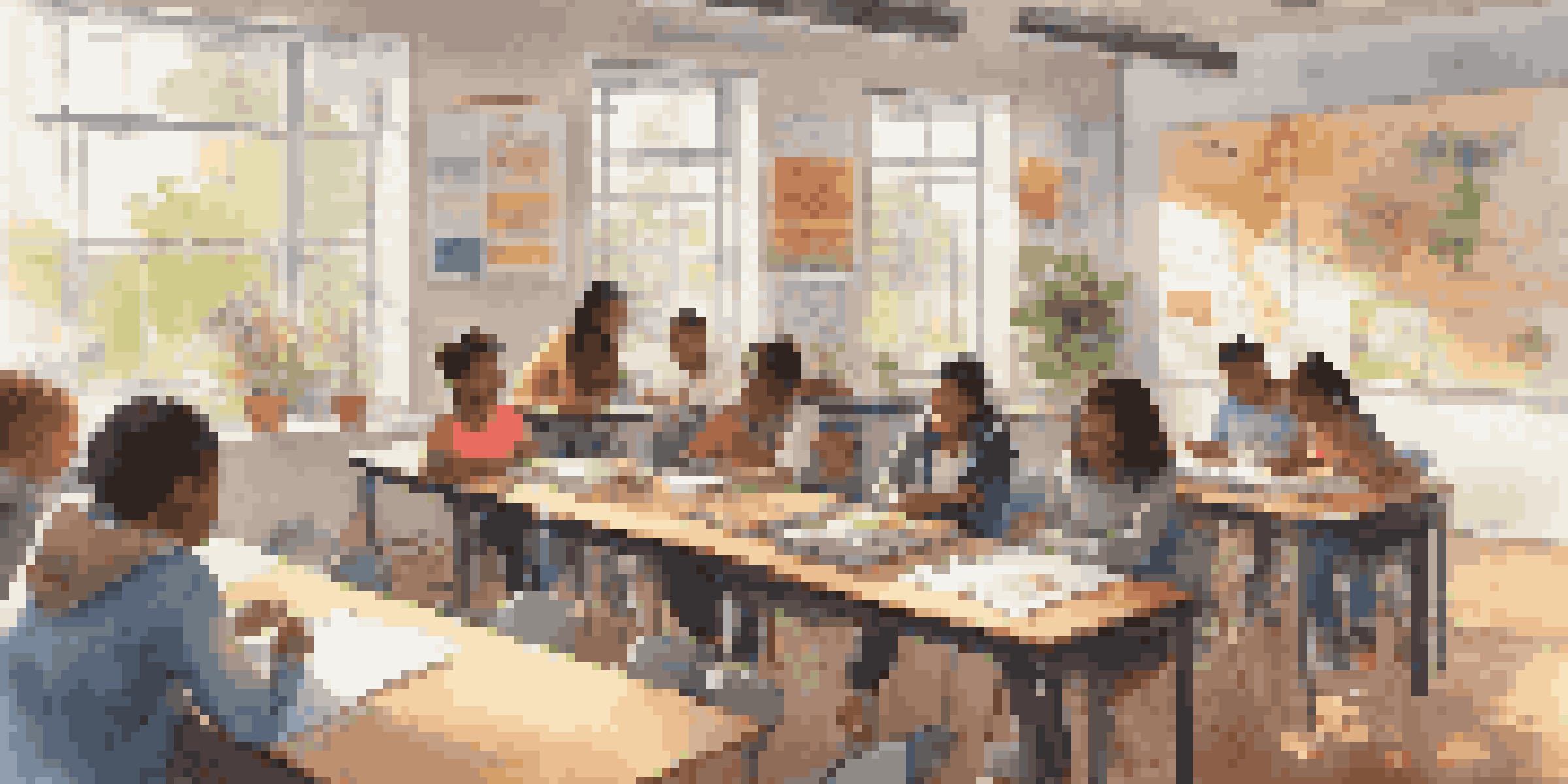Strategies for Implementing Flipped Learning in Digital Spaces

Understanding Flipped Learning: A Quick Overview
Flipped learning is an innovative educational approach that reverses traditional teaching methods. Instead of delivering lectures in class and assigning homework, students engage with instructional content beforehand, allowing precious classroom time to be used for interactive activities. This method encourages active learning and gives students more control over their educational journey.
The essence of flipped learning is to empower students to take charge of their own learning.
In a flipped classroom, educators often utilize digital spaces to share video lectures, readings, or interactive modules. This shift to online resources enables learners to absorb material at their own pace, revisiting challenging concepts as needed. It's like having a personal tutor available 24/7, providing support tailored to individual learning styles.
Flipped learning not only enhances student engagement but also fosters a collaborative environment during in-person or synchronous sessions. By focusing on discussions and hands-on activities, teachers can facilitate deeper understanding and critical thinking, making the learning experience more meaningful.
Choosing the Right Digital Tools for Flipped Learning
Selecting the appropriate digital tools is crucial for successful flipped learning implementation. Platforms like Google Classroom, Edpuzzle, or Flipgrid can streamline content delivery and foster student interaction. These tools provide a user-friendly interface that makes it easier for educators to distribute materials and for students to access them anytime, anywhere.

When choosing tools, consider the specific needs of your classroom and the types of content you’ll be sharing. For instance, if videos are a central component, tools like Edpuzzle allow teachers to embed quizzes directly into videos, prompting students to engage actively while watching. This interactivity can significantly boost retention and understanding.
Flipped Learning Enhances Engagement
This innovative approach encourages students to engage with content beforehand, allowing for more interactive and meaningful classroom experiences.
Additionally, ensure that the tools you select promote collaboration and communication among students. Features like discussion boards, comment sections, and group projects can enhance peer-to-peer learning, creating a vibrant online learning community. The right tools can transform the learning experience from passive consumption to active participation.
Creating Engaging Content for Flipped Learning
Content quality is essential for effective flipped learning. Engaging materials, whether videos, articles, or interactive quizzes, can make all the difference in capturing students’ interest and ensuring they complete assignments. Consider using a mix of formats to cater to different learning preferences, from visual learners to those who prefer reading or hands-on activities.
In a flipped classroom, the focus shifts from teaching to learning, creating a more engaging and personalized educational experience.
When producing video lectures, keep them concise and focused on key concepts. Aim for a duration of around 5-10 minutes to maintain attention, and incorporate visuals, animations, or even storytelling techniques to make the material more relatable. Think of it as crafting a mini-movie, where the goal is to entertain while educating.
Don’t forget to include opportunities for self-assessment and reflection within your content. Quizzes, polls, or reflective prompts can encourage students to think critically about what they’ve learned, helping to reinforce their understanding and prepare them for in-class activities.
Designing Interactive Activities for Classroom Time
The classroom time in a flipped learning model is where the magic happens. It’s crucial to design interactive activities that encourage collaboration and critical thinking. Think of this time as a workshop, where students can apply what they’ve learned and engage in meaningful discussions.
Group projects, case studies, and problem-solving challenges are excellent ways to facilitate interaction. By working together, students can share diverse perspectives and learn from one another, fostering a sense of community. This collaborative atmosphere not only enhances learning outcomes but also builds important social skills.
Choosing the Right Tools Matters
Selecting appropriate digital tools, like Google Classroom or Edpuzzle, is crucial for facilitating content delivery and promoting student interaction.
Additionally, consider incorporating technology during these activities. Using tools like breakout rooms for small group discussions or collaborative documents for group projects can enhance engagement and creativity. The goal is to make classroom time dynamic, allowing students to explore concepts in-depth while having fun.
Assessing Student Learning in Flipped Environments
Assessment in a flipped learning environment can be both formative and summative. Formative assessments, such as quizzes or peer reviews, provide ongoing feedback and can help gauge student understanding throughout the learning process. These assessments are invaluable for identifying areas where students may need additional support or clarification.
Summative assessments, on the other hand, evaluate student learning at the end of a unit or course. Consider using a mix of traditional tests and project-based assessments that reflect students’ ability to apply their knowledge in real-world scenarios. This approach not only measures understanding but also promotes higher-order thinking skills.
Incorporating self-assessment opportunities can also empower students to take ownership of their learning. By reflecting on their progress and identifying strengths and weaknesses, they can set personal goals for improvement, fostering a growth mindset and encouraging lifelong learning.
Fostering a Supportive Learning Community Online
Building a supportive online learning community is vital for the success of flipped learning. Encourage open communication and create a safe space where students feel comfortable sharing ideas and asking questions. This sense of belonging can significantly enhance motivation and engagement, making students more likely to participate actively.
Regular check-ins, whether through video calls or discussion forums, can help strengthen connections among students. Consider implementing peer mentoring programs where students can support each other, fostering collaboration and a sense of responsibility. By encouraging relationships, you create a more inclusive environment.
Creating Community Boosts Learning
Building a supportive online learning community fosters collaboration and motivation, making students more likely to participate actively.
Moreover, celebrate achievements and milestones, no matter how small. Recognizing hard work and progress can boost morale and motivate students to push themselves further. A thriving community not only enhances the learning experience but also prepares students for collaborative endeavors in their future careers.
Overcoming Challenges in Flipped Learning Implementation
While flipped learning offers numerous benefits, it’s essential to acknowledge and address potential challenges. One common obstacle is ensuring that all students have access to the necessary technology and internet connectivity. To mitigate this, consider providing alternative resources, such as printed materials or recorded lectures, for students who may face barriers.
Another challenge is student engagement with pre-class materials. Not all learners may take the initiative to complete assignments ahead of time, which can hinder the effectiveness of in-class activities. To counter this, consider incorporating accountability measures, such as participation grades or interactive quizzes that encourage students to engage with the material.

Lastly, be prepared to adapt your strategies based on feedback and outcomes. Flexibility is key in any educational approach, and being open to adjustments can enhance the learning experience for everyone. By recognizing challenges as opportunities for growth, you can create a more resilient and effective flipped learning environment.